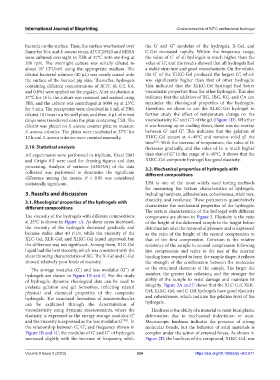Page 342 - IJB-9-2
P. 342
International Journal of Bioprinting Characterization of BITC antibacterial hydrogel
bacteria on the surface. Then, the surface was burned over the G’ and G’’ modulus of the hydrogels, X-Gel, and
flame for 30 s, and S. aureus strain ATCC25923 and MRSA C-Gel increased rapidly. Within the frequency range,
were cultured overnight in TSB at 37°C with swirling at the value of G’ of all hydrogels is much higher than the
200 rpm. The overnight culture was serially diluted to value of G’’, and the results showed that all hydrogels had
7
about 10 CFU/mL using the appropriate medium. The a stable structure and good viscoelasticity. On the whole,
diluted bacterial solution (40 µL) was evenly coated onto the G’ of the XLKC-Gel produced the largest G’’, which
the surface of the burned pig skin. Thereafter, hydrogels was significantly higher than that of other hydrogels.
containing different concentrations of BITC (0, 0.2, 0.6, This indicated that the XLKC-Gel hydrogel had better
and 0.8%) were applied on the pigskin. After incubation at viscoelastic properties than the other hydrogels. This also
37°C for 16 h, the culture was removed and washed using indicates that the addition of XG, LBG, KG, and CA can
PBS, and the culture was centrifuged at 8000 ×g at 25°C maximize the rheological properties of the hydrogels.
for 5 min. The precipitates were dissolved in 1 mL of PBS; Therefore, we chose to use the XLKC-Gel hydrogel to
diluted 10 times in a 96-well plate; and then, 4 µL of mixed further study the effect of temperature change on the
drops were transferred onto the plate containing TSB. The viscoelasticity (G’ and G’’) of the gel (Figure 1D). Whether
diluent was placed on S. aureus counter plate to measure it was heating up or cooling down, there was no overlap
S. aureus colonies. The plates were incubated at 37°C for between G’ and G’’. This indicates that the gelation of
12 h and S. aureus colonies were counted manually. XLKC-Gel occurs at 4~40°C and remains solid all the
time . With the increase of temperature, the value of G›
[32]
2.10. Statistical analysis decreases gradually, and the value of G› is much higher
All experiments were performed in triplicate. Excel 2003 than that of G” in the range of 4~40°C, it shows that the
and Origin 8.5 were used for drawing figures and data XLKC-Gel composite hydrogel has good elasticity.
processing. Analysis of variance (ANOVA) of the data 3.2. Mechanical properties of hydrogels with
collected was performed to determine the significant different compositions
difference among the means. P < 0.05 was considered
statistically significant. TPA is one of the most widely used testing methods
for measuring the texture characteristics of hydrogels,
3. Results and discussion including hardness, adhesiveness, cohesiveness, stickiness,
3.1. Rheological properties of the hydrogels with elasticity, and resilience. These parameters quantitatively
different compositions characterize the mechanical properties of the hydrogels.
The texture characteristics of the hydrogel with different
The viscosity of the hydrogels with different compositions components are shown in Figure 2. Elasticity is the ratio
at 25°C is shown in Figure 1A. As shear stress increased, of the height of the deformed sample to the height before
the viscosity of the hydrogels decreased gradually and deformation after the removal of pressure and is expressed
became stable after 40 r/1/s, while the viscosity of the as the ratio of the height of the second compression to
XLC-Gel, XLK-Gel, and XLKC-Gel liquid improved, but that of the first compression. Cohesion is the relative
the difference was not significant. Among them, XLK-Gel resistance of the sample to second compression following
liquid had the best viscosity, which was consistent with the first compression and refers to the size of the internal
shear thinning characteristics of XG. The X-Gel and C-Gel binding force required to form the sample shape; it reflects
showed relatively poor levels of viscosity. the strength of the combination between the molecules
The storage modulus (G’) and loss modulus (G”) of or the structural elements of the sample. The larger the
hydrogels are shown in Figure 1B and C. For the study number, the greater the cohesion, and the stronger the
of hydrogels, dynamic rheological data can be used to ability of the sample to resist damage and maintain its
evaluate gelation and gel formation, reflecting related integrity. Figure 2A and F shows that the XLC-Gel, XLK-
physical and chemical properties of the composite Gel, XLKC-Gel, and C-Gel hydrogels have good elasticity
hydrogels. The structural formation of macromolecules and cohesiveness, which indicate the gelation level of the
can be explained through the determination of hydrogels.
viscoelasticity using dynamic measurements, where the Hardness is the ability of a material to resist local plastic
elasticity is expressed as the energy storage modulus G’ deformation due to mechanical indentation or wear.
and the viscosity is expressed as the loss modulus G’’ . In Macroscopic hardness indicates the presence of strong
[31]
the relationship between G’, G’’, and frequency shown in molecular bonds, but the behavior of solid materials is
Figure 1B and 1C, the modulus of G’ and G’’ of hydrogels complex under the action of external forces. As shown in
increased slightly with the increase of frequency, while Figure 2D, the hardness of the compound, XLKC-Gel, was
Volume 9 Issue 2 (2023) 334 https://doi.org/10.18063/ijb.v9i2.671

